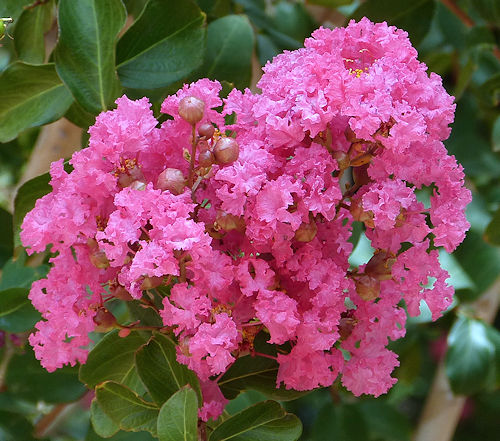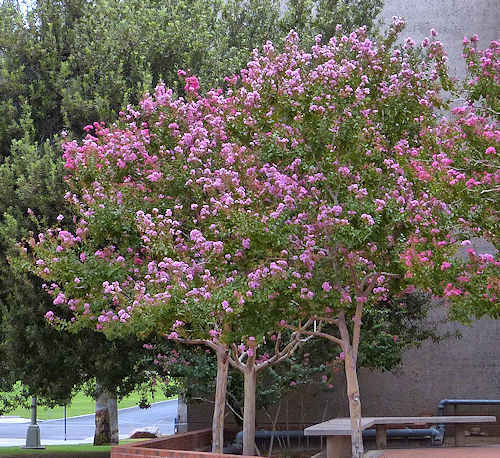Growing Lagerstroemia indica:
Crepe Myrtle
Back to Trees and Palms
Description
Form: A many-stemmed shrub or small tree.
Lifespan: 20-50 years.
Leaf retention: Deciduous.
Growth rate: Moderate to rapid.
Mature Size: 1-30' (0.3-9m) high and 1-25' (0.3-7.6m) wide, depending on cultivar and rootstock.
Flowers: Crinkled red, purple, pink or white petals, in clusters,
Bloom: In summer, for one to three months.
Fruit: A dry seed capsule.
Leaves: Green, ovate, possibly turning yellow, orange or red in fall. Crepe Myrtle is often the last plant to leaf out in spring. It provides moderate shade.
Stems: Densely branching, fluted, the bark sheds in summer and fall. No thorns.
Roots: Shallow and fibrous. It may have a grafted rootstock to reduce its size. Its extensive roots prevent other plants from growing underneath.
Wildlife: This plant is unattractive to most wildlife except aphids and molds.
Toxic / Danger: No.
Origin: Asia.
Form: A many-stemmed shrub or small tree.
Lifespan: 20-50 years.
Leaf retention: Deciduous.
Growth rate: Moderate to rapid.
Mature Size: 1-30' (0.3-9m) high and 1-25' (0.3-7.6m) wide, depending on cultivar and rootstock.
Flowers: Crinkled red, purple, pink or white petals, in clusters,
Bloom: In summer, for one to three months.
Fruit: A dry seed capsule.
Leaves: Green, ovate, possibly turning yellow, orange or red in fall. Crepe Myrtle is often the last plant to leaf out in spring. It provides moderate shade.
Stems: Densely branching, fluted, the bark sheds in summer and fall. No thorns.
Roots: Shallow and fibrous. It may have a grafted rootstock to reduce its size. Its extensive roots prevent other plants from growing underneath.
Wildlife: This plant is unattractive to most wildlife except aphids and molds.
Toxic / Danger: No.
Origin: Asia.
Cultivation and Uses
USDA hardiness zones: 7b-10. It often dies to the ground in zone 6 but recovers in spring or summer.
Heat tolerant: Only up to 100°F (38°C). It experiences leaf scorch and premature leaf loss above 100°F (38°C).
Drought tolerant: Yes.
Sun: Full sun except that it needs afternoon shade in hot desert climates. Avoid reflected heat and light.
Soil: Well draining, deep, clay or loam, pH 5.1-7.8 (strongly acidic to slightly alkaline). These plants are subject to root rot in wet soil.
Water after becoming established: For plants over two years old, monthly in summer, every two months in winter.
Mulch: Spread organic material under canopy but 1' (30cm) away from the trunk. This will reduce water loss and heat stress.
First Two Years' Care: Water after planting, and every other day for the first month, reducing to weekly as temperatures cool. In the second year, watering should be every week in summer and every two weeks in winter.
Planting: Compact cultivars can be grown in containers.
Prune: Removal of seed capsules triggers a second bloom. Blooms appear on new wood, so prune in winter. Late spring pruning reduces blooms. Never top chop a Crepe myrtle tree (pollarding). Purchase a dwarf tree or shrub instead, or allow the plant to grow to its natural height.
Litter: Spent flowers, leaves in fall.
Propagation: Seed or cuttings.
Pests: Aphids, powdery mildew.
Uses: Summer ornamental.
USDA hardiness zones: 7b-10. It often dies to the ground in zone 6 but recovers in spring or summer.
Heat tolerant: Only up to 100°F (38°C). It experiences leaf scorch and premature leaf loss above 100°F (38°C).
Drought tolerant: Yes.
Sun: Full sun except that it needs afternoon shade in hot desert climates. Avoid reflected heat and light.
Soil: Well draining, deep, clay or loam, pH 5.1-7.8 (strongly acidic to slightly alkaline). These plants are subject to root rot in wet soil.
Water after becoming established: For plants over two years old, monthly in summer, every two months in winter.
Mulch: Spread organic material under canopy but 1' (30cm) away from the trunk. This will reduce water loss and heat stress.
First Two Years' Care: Water after planting, and every other day for the first month, reducing to weekly as temperatures cool. In the second year, watering should be every week in summer and every two weeks in winter.
Planting: Compact cultivars can be grown in containers.
Prune: Removal of seed capsules triggers a second bloom. Blooms appear on new wood, so prune in winter. Late spring pruning reduces blooms. Never top chop a Crepe myrtle tree (pollarding). Purchase a dwarf tree or shrub instead, or allow the plant to grow to its natural height.
Litter: Spent flowers, leaves in fall.
Propagation: Seed or cuttings.
Pests: Aphids, powdery mildew.
Uses: Summer ornamental.
Comments
This plant is a member of the Loosestrife family (Lythraceae). Some drawbacks of this overused plant are its dead look in winter, its lack of wildlife appeal, and the "plastic" look of its flowers that do not match native vegetation.
The problem of not flowering can be caused by insufficient sunlight, temperatures too cool, too much water or rain, and over-fertilization.
Do you have additional information or a different experience for these plants that you would like to share? Email info@GardenOracle.com. All contributions are welcome and appreciated.
This plant is a member of the Loosestrife family (Lythraceae). Some drawbacks of this overused plant are its dead look in winter, its lack of wildlife appeal, and the "plastic" look of its flowers that do not match native vegetation.
The problem of not flowering can be caused by insufficient sunlight, temperatures too cool, too much water or rain, and over-fertilization.
Do you have additional information or a different experience for these plants that you would like to share? Email info@GardenOracle.com. All contributions are welcome and appreciated.


Latest update: September, 2024
© 2008-2025 by GardenOracle.com

